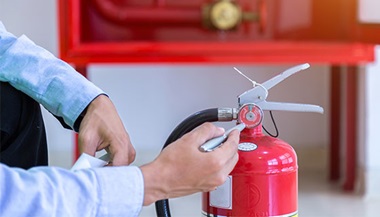Don’t Fall for These Autumn Fire Safety Risks
Featured Expert
The crisp autumn air signals the changing of seasons, but it also brings fire safety risks associated with fall activities. As we head into the cool weather, prevention of burn injuries is paramount, says Mark Fisher, M.D., director of the Johns Hopkins Burn Center. “Preventing a burn is always better than treating a burn.”
Campfire Safety
According to the National Fire Protection Association, campfire accidents send thousands to the emergency room with burn injuries each year. "Fire safety should be a priority for all adults who plan on lighting campfires or use fire in their homes for cooking and warmth,” says Fisher.
Next time you’re huddled around the fire, stay cozy and safe with these tips:
- Be sure you are at least 25 feet away from structures or anything else that can burn before building a fire. Choose an open, level location and clear away any dry leaves and sticks, overhanging branches and shrubs.
- Never use gasoline, kerosene or any other flammable liquid to start a fire. Instead, use a match or lighter to ignite tinder (small twigs and dry leaves); add larger sticks and pieces of dry wood.
- Keep the fire small and controlled, and never leave it unattended.
- Do not stand too close to the fire or play around it, and do not attempt to jump over it. Keep an eye on children and pets so they don’t get too close to the flames either.
Keep a hose, a bucket of water, or a shovel and dirt or sand nearby to extinguish the fire once you’re finished. Be sure the fire is completely out before leaving the site — any remaining embers could ignite, with disastrous consequences.
Halloween Decorations and Fire Safety
Dried flowers, crepe paper, cornstalks and decorative scarecrows may make your home look festive for fall, but these classic decorations can also pose a scary fire risk. The National Fire Protection Association says flammable decorations are the first things to ignite in 900 reported home fires each year; two of every five of these incidents start by a candle.
Decorate safely and keep these tips in mind:
- Don’t put decorations near open flames and other heat sources, such as light bulbs and heaters.
- Check that any decorative lights have been tested for safety by a recognized testing laboratory. Examine each set of lights for broken sockets, frayed wires or loose connections, and discard any damaged sets. Be careful not to overload sockets when plugging in lights and other electronic decorations.
- Consider glow sticks or battery-operated candles instead of real candles when lighting your jack-o’-lanterns or other luminaries. If you do use real candles, light them with long, fireplace-style matches or a utility lighter. Keep lit decorations off of doorsteps, yards and sidewalks where excited trick-or-treaters may knock them over.
- Check that no decorations are blocking your home’s exits or pathways, so you have a clear escape route in case of an emergency.
To make sure children enjoy their evening of trick-or-treating, follow these tips:
- Avoid costumes with loose, trailing fabrics or other hanging parts, which can catch fire on open flames. Check the labels on costumes, wigs and props to be sure they are made with flame resistant or retardant materials.
- Double-check that the eyeholes in masks are large enough that children can see and avoid any trips or falls, or brushes with open flames. If visibility is an issue, use makeup or face paint instead of masks.
- Provide flashlights or glow sticks to carry for lighting, and use glow-in-the-dark reflective tape on costumes for extra visibility near roads.
- Talk with children about fire safety before heading out, reminding them to stay away from open flames.
- Practice the “stop, drop and roll” technique. “This is a great time of the year for adults to teach children about fire safety, as well as first aid measures if someone gets hurt,” Fisher says.
'Tis the Season for Holiday Cooking Safety

Hectic holiday preparations may prove distracting when it comes to safety in the kitchen. With these tips in mind, you and your loved ones are apt to have a happy — and safe — holiday season from the kitchen to the table.
Burning Leaves Safely
Falling leaves are often the first signs of the seasonal shift — and of more yardwork. As the piles of raked leaves build up, you’re faced with a new problem: how to dispose of them.
A popular method of disposal is to burn them. And if you’re burning leaves, it may be tempting to throw trash onto the pile, such as household garbage, construction debris or old papers. “While leaves and grass clippings can be disposed of through burning, we caution against burning trash, which can result in unpredictable explosions and emit toxic fumes,” says Fisher.
Burning materials such as yard waste, grass clippings and leaves may be permissible depending on your town’s ordinances on open burning. Do not use flammable liquids to ignite the debris. Keep an eye on the fire at all times and be prepared to extinguish it at any moment — if the wind picks up or the weather changes, an open burning can quickly get out of control.
Safe alternatives to burning leaves include:
- Recycling. Tree limbs, grass clippings, leaves and brush can be composted, mulched or chipped into landscaping material.
- Scheduling a pickup. Many cities and towns provide curbside collection of bagged leaves, although there are limitations on what they will pick up — check with your local public works department.
- Calling a yard waste or junk removal service. They will take the debris to the dump or recycling center.
How to Treat a Burn
Accidents sometimes happen despite our best efforts to practice fire safety, so it’s good to be prepared. Should you experience a painful burn, contact your doctor or go to the emergency room for care.







